We use cookies to ensure that we give you the best experience on our website. If you continue without changing your settings, we will assume that you are happy to receive all cookies on the Business Car website. However, if you would like to, you can change your cookies at any time

The start point for the best source of fleet information |
Final report: Citroen C5 Aircross long-term test
Date: 05 October 2021 | Author: Guy Bird
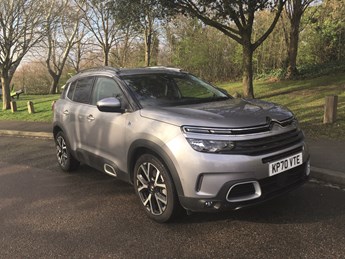
|
|
||||||||||||
Final Report: Plugged out of the C5
In-between times - like in-between car technologies - can feel a bit weird. The sense of flux most of us have felt at one point or another over the past 18 months of Covid-19 pandemic-related disruption is a bit like driving a plug-in electric hybrid - for me at least. The Citroën C5 Aircross PHEV is not fully petrol and only a bit electric.
Explaining it to interested passengers is complicated, as it is sort of green, but only if your life and location allow for relentless two-to-three-hour recharging sessions of the small battery to ensure emission-free driving, and only in batches of 25-30 miles at a time.
As I discovered with our previous long-termer, the Volvo XC40 PHEV, the sort of frequency of recharge required to keep plug-in hybrids emission-free for even half the time requires easily accessible off-street parking, either at home or at work, plain and simple. But as a London-based freelancer living in a terraced house working from home more than ever in the past year, neither option was easy. My C5 charging succeeded best when in the town centre, where I could charge close to a meeting or job. Central London is blessed with a decent amount of charging options compared with other UK cities, and when plugged in, my parking warden worries were nil and congestion charge payments zero (until October this year at least, when only full EVs will be allowed in the zone for free).
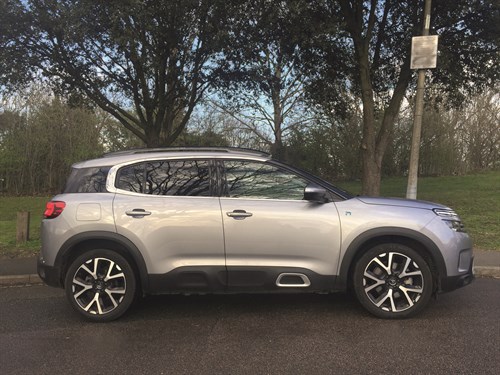
But those charging moments were too few, which explains my deeply shabby - or perhaps just honestly real-world - fuel figures compared with Citroën's official 166mpg combined. My best fill-up was 43.5mpg, aided by three recharges accounting for some 75 electric-only miles within the calculations, and 27.0mpg was my worst, aided by none. The final average was 33.9mpg, merely okay in relation to a regular petrol compact SUV living in the city. When I had reason - and government approval - to go further afield, from South London to deep North Norfolk and back, I thanked my lucky stars for this PHEV. Why? Because the ability to just drive without forward planning and anxious range-watching, and knowing that if no chargers could be found I would still be in shooting distance of a petrol station anywhere in the country was a good feeling.
Whether under petrol or electric power, the C5 Aircross did most things a 21st-century car should do very well, and some things better than most. Its trump card is still comfort. All but the harshest speed bumps were evened out through its combination of cossetting seats and gentle but clever suspension, and its practical load-lugging skills were used on numerous occasions. The C5's biggest weakness is that its software and hardware (from screen tech to app) lag behind many. The centre screen in particular is slow to react to human inputs, unintuitive in its design, layout and layers, and to get the most out of it, your personal phone and computer need to be bang up to date, although that is increasingly true for many new cars.
So all things considered, would I recommend the C5 Aircross PHEV? If you have access to off-street parking and a charging wall-box, are diligent in plugging in, and need to do longer journeys regularly where comfort is more of a priority than screen tech, then it's a yes. But if your life can't tick all those boxes, it's a no from me. Personally, I'm now ready for an all-electric car challenge, for reasons I will hopefully be able to explain in the coming months.
5th Report: Charging plus, screen minus
t was without doubt a beautiful moment. The second my new iPhone 12 settled on the inductive charging mat under the C5's centre console, a little green battery icon lit up above the smartphone to indicate that the car had indeed accepted my phone as one of its own and commenced charging. By comparison, leaving my old iPhone 6 Plus in the same space for as long as it liked got me absolutely nowhere. The phone was simply too old to 'chat', too incompatible to care.
So, it's happy days now to avoid the fiddly plug-in phone process every time I get into the C5. The only small downsides to that big upside are that I tend not to use Apple CarPlay as often as I used to, because it doesn't work without the cable, and my phone gets quite hot when left there for longer journeys and can feel unsettlingly hot in my pocket for a little while afterwards. When it cools down again, I can cope.
However, one other problem of using the C5 Aircross' in-house mapping rather than Apple's is that, although the graphics are decent, the software powering them is prone to a 'lagginess' that can be really frustrating when trying to input satnav addresses. It take an age for the screen to fire up, draws the map in slow stages and renders input letters from a satnav address so ponderously on screen that you can easily believe the computer hasn't acknowledged your finger presses at all. So much so, you then re-input, just in time for all of them to appear at once - like waiting for London buses - rendering the word crazily misspelt and often resulting in having to start all over again. This is annoying.
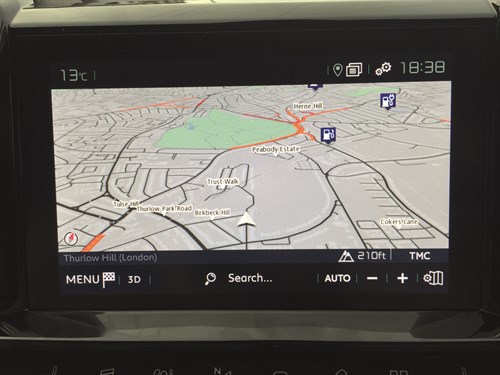
A better element of the C5 Aircross PHEV's screen tech is its ability to offer free real-time traffic updates for the mapping, speed camera alerts and more. Citroen promotes signing up to its smartphone app for remote charging and range information (and is decent) and also downloading an app to your main computer as a way to update the car's software and graphics updates. I went through that somewhat long process and started downloading a mapping software update until I realised it would take up 17-plus gigabytes - or half of my admittedly ageing iMac's remaining memory space. Knowing that would have ground my computer to a virtual halt, I stopped the download quickly. I have since bought a brand-new iMac for work - which was probably overdue too and has much more space - but it brought home the reality that the process of getting the best out of many new (electric or part-electric) cars' infotainment capability these days increasingly requires a really up-to-date smartphone and computer to go with it.
A smartphone with a long-lasting battery life and good storage space also becomes crucial when dealing with the array of different electric recharging apps needed to traverse the country and stay as electric as possible. The C5 is only a PHEV of course, so not fully reliant on electric power, but without a decent phone the charging process can be painful. With my new one I've been able to sign-up fairly easily to half a dozen new charging apps in the past two months that I didn't have before - some on the spot, at the parking location in question - and have also enjoyed the C5 PHEV's congestion exempt status when parking in a few central London locales. Three or four electric top-ups between the past two petrol fill-ups while mainly using the car in the city has resulted in a 43.5mpg figure overall, which is a 10% jump on the previous report's figure. That's progress.
4th Report: Good boot, no silly walk
Lately, we've had need to concentrate on the rear of our C5 Aircross Hybrid more than the front. Various family and work loads of different sizes and shapes have tested the C5's lugging capability to the max. The good news is that it passed with flying colours, but as much for its generous apertures as its overall capacity.
Why? Because although the C5 Aircross Hybrid's basic 460L boot space isn't the biggest in the compact SUV plug-in business - the VW Tiguan eHybrid (476L), DS7 E-Tense (555L) and Hyundai Tucson plug-in hybrid (558L) are all bigger - its dimensions make it really flexible. Note that the comparative selection is only with other PHEVs, which tend to lose boot space compared to their solely petrol or diesel-powered counterparts through extra powertrain (and sometimes cable) packaging needs. This can equate to 40-140L depending on make and model, and - we suspect - carmakers' differing measuring techniques too. On the C5 Aircross, specifically, the difference is 120L - on account of its fixed load floor with a cubbyhole underneath to store charging cables, rather than the two-stage height floor of the regular 580L C5.
That rear seats-up space can be boosted to 600L for the PHEV, and up to 720L for the regular C5, by sliding those rear seats forwards - but that's something only possible if your rear passengers are small kids plugged into child seats or have very skinny legs. Things become more equitable between the two powertrains' luggage-carrying when those three rear seats are folded, which they do individually and easily to an almost flat position, by pulling a loop situated at each seat's hip point.
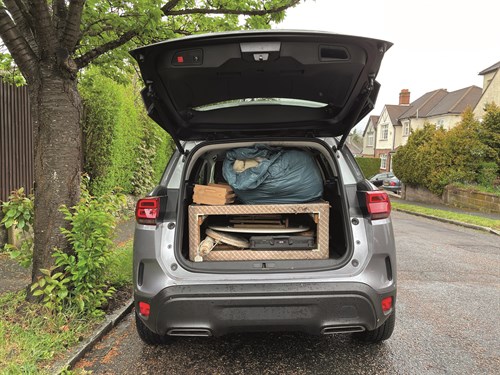
With this bigger space revealed, all sorts of things - from half a double bed base to curtain poles and book cabinets - can be slotted into the C5, due to its usefully wide 1m-plus hatchback aperture and 1.6m-plus load length, to the back of the front seats. That floor height aperture does diminish slightly as it tapers inwards to the roofline, making the car's silhouette less boxy and more curvy, but all things considered, the seats-down C5 Aircross luggage space is generous and accessible.
A less impressive detail of the C5's boot is the way it opens. Like so many modern hatchbacks, trying to assist its upward opening trajectory can get its electronics in a flap, so once the boot release button on the car itself is touched, leave the car to do its thing, or it can stop in a halfway up position thinking perhaps that some danger above awaits. Using the separate boot-opening button on the key fob tends to yield more consistent results.
And unless you like running the risk of looking foolish in public, getting your shoes dirty or even bashing your shin on the back of the car, I can thoroughly recommend not engaging with the foot-waggle-under-the-rear-bumper alternative approach to boot opening. Why so many carmakers fell for this option from a no-doubt enthusiastic salesman at an automotive supplier some years back is anyone's guess, but if you do want to perfect the art of foot-based boot opening for the C5 Aircross please remember to follow the handbook's wise words to the letter.
"The kicking movement must be given forwards, smoothly, not too fast and with a vertical movement from low to high," it states in a line that could be taken directly from an instruction manual for Monty Python's infamous Ministry for Silly Walks, before adding the slightly vague but tricky advice to "raise the foot sufficiently and remove it immediately". For the avoidance of doubt, you won't catch me doing any such thing. I'll just carry less to the car and/or find somewhere to put the baggage down before blipping the blipper and opening up what is otherwise still a very fine boot.
3rd Report: Unlocking C5's hybrid skills
There's a short commute I've undertaken regularly during the past year's various lockdowns to deliver food to an elderly relative that's very uphill one way and mainly downhill on the way back. Sometimes I do that by bicycle, but if it's wet or very cold or both, I drive. By bike, it's literally an uphill struggle to get up the steep hill and I expend considerable energy doing so, but once at the flat top ridge to my destination I know that downhill will be a breeze, in every sense, from the lack of energy required on my part, to the wind in my hair.
The same has always been said in terms of fuel consumption in regular cars, - more fuel is burned uphill than down - but in hybrids, the cycling-style benefits of coasting become more apparent and, through a new (to me at least) display on the C5, crucially tangible too.
As a fairly regular tester of numerous hybrid cars over the years, I've become accustomed to screens that show diagrams of cutaway cars with moving illustrations of how the brake regeneration is working, or perhaps increasing 'digital leaves' popping up like extra men in an old video game to denote how eco-consciously you're driving on any given journey. But one C5 driver display option that records how much of your current journey has been emission-free has psychologically cut-through more than most (for this driver). I stumbled upon the screen by accident when fiddling with the steering wheel controls and at first it simply showed the words 'ZERO Emission' with a rather unimpressive 0% alongside it. But as I drove further I started to see how acting in a (usually) one-pedal manner and with the gear selector in 'B+' for maximum brake re-gen, increased the zero emission percentage figure. Then it started to get interesting, maybe even fun.
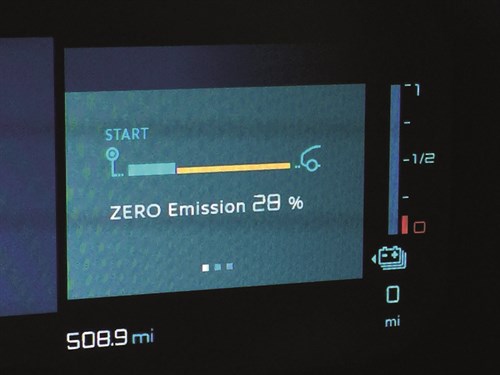
On steady inclines - like on the outward leg of my sometimes cycled food delivery mission - this hybrid car has to resort to the petrol tank for energy and the zero emission percentage figure displayed stays stubbornly low, perhaps no more than 20-30%. But with careful and gentle driver stewarding on the downhill leg, accelerating gently and re-gen braking wherever possible, the percentage display on the most recent return leg of that same journey gave up a zero emission reading of 81%. That felt very good indeed, a bit like free-wheeling down a long hill on a bicycle expending no energy at all, except that the C5 also manages to capture some of the braking energy required to keep the car safely in control on such declines.
Hybrid cars have been able to do this for years of course, but the clarity of the driver display in showing how the car is doing it, helps encourage this driver to continue maximising his 'zero emission' miles more than green digital leaves or a graphically impressive but ultimately sometimes slightly nebulous car cutaway. As Citroën's own C5 handbook sagely points out: "In hybrid mode and depending on the speed, it is possible to drive in 100% electric mode if the battery charge level is sufficient and the demands for acceleration are moderate." Of course, other driving modes are available - Electric (full-electric propulsion as long as the battery charge holds out) and Sport, where electric power supplements the petrol engine as long as there is energy left in the battery, but the middle-way Hybrid driving mode is working out well right now for me.
2nd Report: Riding high and comfortably
Unlike some brands with nebulous distinctive attributes or historic values, there are certain things a driver expects from a Citroën, and great ride comfort is one of them. Anyone lucky enough to have driven a classic DS will know what I'm referring to and Citroën engineers throughout the decades have followed this dignified pursuit.
Despite arguably losing its way somewhat on this core brand value in the late-1990s and early 2000s, current Citroën vehicles have reclaimed it and with some aplomb. Indeed, one of the first things I noticed after swapping out of our previous Volvo XC40 test car and into the Citroën C5 Aircross, is just how cosseting its ride is. Potholes and variably-sized speed bumps common to London's streets have instantly become much less of a problem (and the XC40 wasn't that bad). The C5's front McPherson strut and rear multilink suspension system with progressive hydraulic cushions are the reason why, even with big 19in alloys fitted, which can often make a car look good at the expense of ride. Not in this case, the 19in lend the C5's side profile a good proportional stance, while inside we glide along oblivious to the road's many imperfections. As Citroën's website explains: "While conventional suspension systems comprise of a shock absorber, a spring and a mechanical stop, the progressive hydraulic cushions system adds two hydraulic stops on either side, one for rebound and the other for compression. In cases of major compression and rebound, they gradually slow down movement to avoid sudden jolts. In cases of slight compression and rebound, they absorb dips and bumps in the road to deliver a 'magic carpet ride' effect."
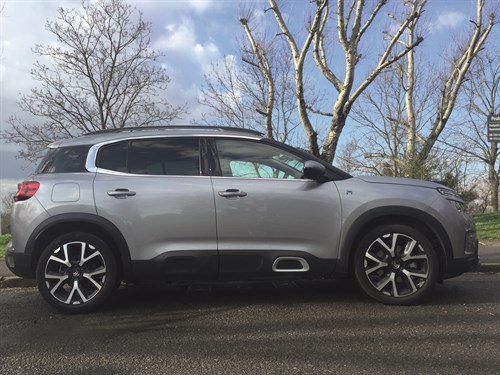
For once, the marketing blurb and catchphrase is spot-on. I'm not sure Aladdin would trade in his actual magic carpet, but the C5 is undoubtedly a safer (real-world) bet and more comfortable with it, courtesy of Citroën's Advanced Comfort technology, which combines high density foam in its seats and a 15mm thickened and textured foam on the surface for less sag while not feeling like an upholstered brick. In addition, front seats are height-adjustable and heatable, while the driver's seat on our model has a multipoint massage system with five programmes. We've tested the three-stage heated seats already and will report on the massaging function in due course.
One other small detail on the C5 that might normally be quite useful - an audible speed camera alert - we've sought to switch off for now. It's not only very noisy and unsettling, but also repetitive, making a loud beep that we can't easily turn down. It's partly situational. There's a speed camera on the corner of my road, so every time we get in the car and drive off, the alarm sounds and does so again when you drive through the speed camera's path. This was starting to drive us a bit potty as we tried to turn it off while out and about without success, until a phone call to a kind PR at Citroën UK HQ told us where, within the central infotainment system, the 'risk areas alert' could be found and un-ticked. In case you're similarly afflicted, it's four layers deep within the navigation system (Menu/Settings/Alerts/Risk Areas Alert). However, on our car's system this item still wouldn't untick unless you put in a destination, let the TomTom system fully load up and then go back through the layers and change it, which by anyone's standards is a little unwieldy. Now I just need to remember to keep to the speed limit. At least the driver display includes traffic signal recognition symbols, so there's little excuse.
1st Report: French lessons with Citroën
It's rarely a worry taking on a Citroën test car. French flair and great ride comfort are usually givens, but quality is an area the marque has historically struggled with and is wanting to address in its newer models. So, with our newly arrived C5 Aircross plug-in hybrid (PHEV), we will be aiming to evaluate that and more for the next half-year.
Compared with our outgoing Volvo XC40 compact SUV, the C5 Aircross is a little longer (4,500 versus 4,425mm) and a bit taller (1,670 versus 1,658mm). These are different enough dimensions that all occupants should be able to feel inside and places the vehicle on the cusp of the compact and mid-size SUV sectors. Rivals vary from the smaller Kia Sportage (4,485mm) to the bigger VW Tiguan (4,509mm) and Ford Kuga (4,614mm).
As veterans of a Citroën Cactus just three years ago, we're well used to the slim, wraparound and joined-up lights and logo front-nose approach, albeit here supplemented with another set of bigger headlights and grille directly below and sat within a higher bonnet, and bigger and taller overall proportion. Inside, passenger space front and back feels generous, and the material quality is less pared back and more premium. Boot space measures up at 460 litres seats up and 1,510 litres with rear seats folded flat. Of particular note are the striking part-nappa leather, part-leather-effect cloth seats, whose brown rectangular-shaped seat-back and squab pads resemble huge rows of enticing chocolate chunk, but without the associated danger of sitting on an actual chocolate bar (especially with heated front seats and driver's seat massage function as part of the overall £1,770 option). This Hype Black Ambience pack is one of this test car's two cost options, the other being the Cumulus grey metallic paint (£545). On brief acquaintance, both seem worth it.
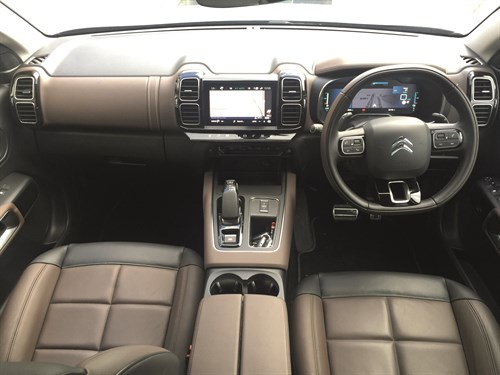
That pushes the original price for the C5 Aircross Shine Plus to £38,150 as tested. But its plug-in hybrid status, 32g/km official CO2 and 33 miles of electric range, means it still only attracts an 11% BIK band from April 2021 (which we're using as the start point of this test, given how few days of the current tax year are left). Beyond the useful fiscal incentive, plugging in as much as we can will of course affect our real-world mpg, but we're under no illusion of getting anywhere near the official 166mpg. We're almost more enthused by the four-cylinder, turbocharged 181hp 1.6-litre petrol engine's ability to drive the wheels and also feed power back into the battery by pressing the Harry Potter-style lighting bolt button to the left of the centre stack, just above the 8-speed auto gear shifter. Taking this approach straight after collection on a 60-70 mile trip has already gained us 23 electric miles to use back in the city without fuss. The B+ gear mode as default at other times gives good re-gen too.
That same engine, alongside the 81kW electric motor, combines to create a hybrid maximum power output of 228hp and a promised 8.7-second 0-62mph time. Although standing-start sprints aren't part of my usual driving road test MO, the C5 certainly does seem usefully sprightly and exceedingly comfortable too, suppressing potholes and speed bumps like few other cars.
Specification on our top-level Shine Plus trim is generous. Safety kit includes collision risk and driver attention alert and traffic sign recognition, while infotainment includes Apple Carplay mirror-linking, and front and rear parking sensors among its standard features (unlike our outgoing Volvo XC40, which charged for much of the latter). It's very early days of course, but we're really looking forward to stretching this C5's legs on some long missions as UK's Lockdown 3 restrictions hopefully keep easing. Fingers crossed.
Standard equipment on Shine Plus:
Six airbags, ESP including traction and stability control, automatic emergency braking, pedestrian and cyclist detection, collision risk and driver attention alert, traffic sign recognition, active lane departure warning and blind spot monitoring, active cruise control, intelligent high-beam LED headlights, hill start assist and electric parking brake, tyre deflation warning system, front and rear parking sensors, reversing parking camera, dual auto aircon, auto wipers and lights, handsfree tailgate, 12.3in TFT colour driver display, 8in central touchscreen with satnav, DAB radio, voice-activated control, Bluetooth, Apple and Android mirror screening, wireless smartphone charging plate, x2 USB sockets, 19in alloys.
Options:
Cumulus grey metallic paint (£545)
Hype Black Ambiance with black nappa leather and black leather effect cloth, heated front seats and driver's seat with massage (£1,770)
Blue Anodised Colour pack, including lower front bumper highlight and Airbump insert, silver roof bar lower face (no cost option)











